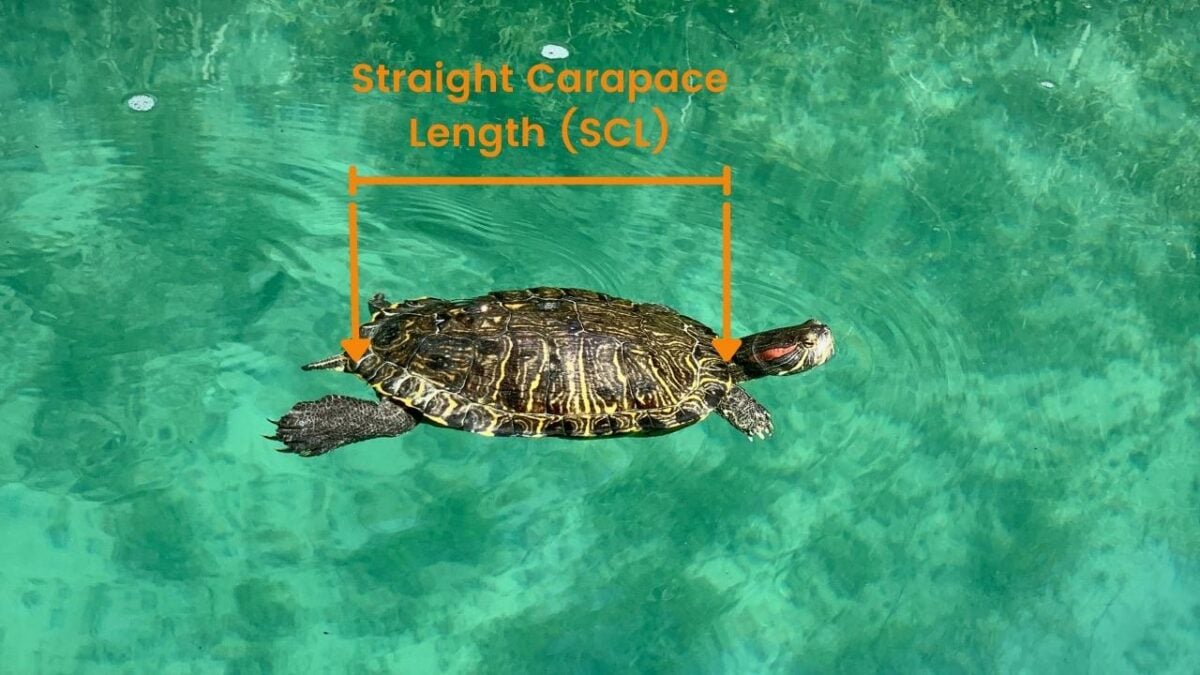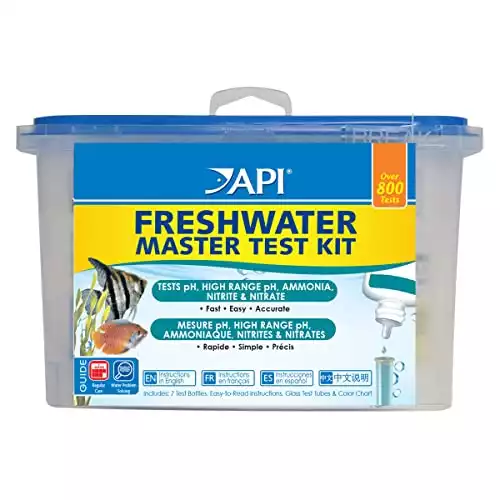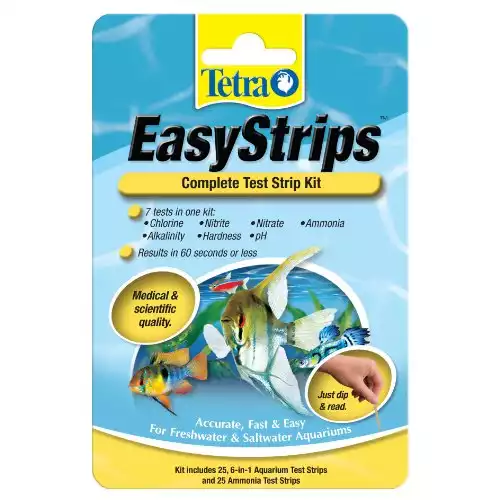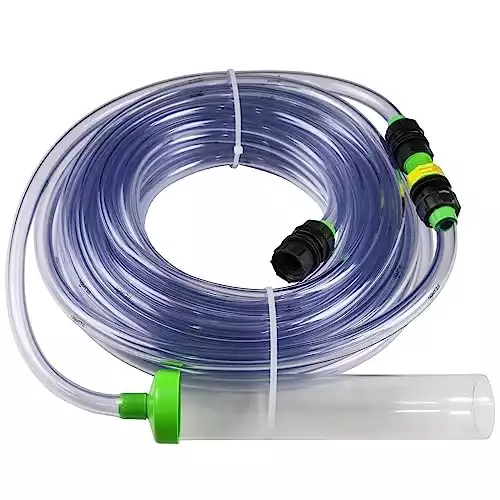
Unfortunately, there’s no such thing as a self cleaning turtle tank.
If you don’t keep your turtle tank clean it’s soon going to look, and smell, like a swamp or sewer, which could lead to your turtle picking up all kinds of health issues including shell rot.
- How Often Should I Clean My Turtle Tank?
- Turtle Tank Cleaning Kit
- What Is The Easiest Way To Clean A Turtle Tank?
- Step 1. Remove Your Turtle
- Step 2. Remove Electrical Items
- Step 3. Remove The Tank Decor
- Step 4. Drain The Tank Water
- Step 5. Move The Turtle Tank To Where You’re Going To Clean It
- Step 6. Remove And Clean The Substrate (If You Have Any)
- Step 7. Mix The Cleaning Solution
- Step 8. Scrub The Tank & Rinse Thoroughly
- Step 9. Return The Tank To The Display Area
- Step 10. Dechlorinate The Water
- Step 11. Reinstall The Electrical Items
- Step 12. Test The Water Parameters
- Step 13. Return Your Turtle To The Tank
- How Do I Keep My Turtle Tank Clean And Clear?
- How Do You Keep Algae From Growing In A Turtle Tank?
- How To Clean A Turtle Tank FAQ
- Closing Thoughts On How To Clean A Turtle Tank…
How Often Should I Clean My Turtle Tank?
There is no ‘one-size-fits-all’ answer to this, every turtle tank is different.
It depends on the size of the tank, what type of turtle you have, how many turtles you have, how good your filter is, do you have plants, etc, etc.
You should be doing some level of cleaning on a daily basis.
If you establish a good tank maintenance schedule you can reduce the frequency of having to perform a deep clean on your turtle tank.
If your turtle tank is starting to smell, you need to up the frequency that you clean it.
Turtle Tank Cleaning Schedule
A good routine to start with for cleaning your turtle tank would be:
Daily:
Remove any visible poop, leftover food, and other gunk.
A small fishing net is great for larger bits and a turkey baster is great for sucking up those annoying small floaty bits of detritus.
Weekly:
Replace at least 25% of the tank’s water to lower ammonia and nitrite and keep the nitrate levels below 40 ppm.
Use a water test kit to see how much / often you need to change the water.
If you find your nitrate levels are over 40 ppm 1 week after changing 25% of the water, you can either change more of the water or do it more frequently.
You also need to keep the tank water topped due to evaporation, if the water level drops too low your turtle may struggle to access its basking area.
Monthly:
Perform a deep clean of your turtle tank and filter.
If you have a large tank with a good quality filter and only one turtle, you may find you can go longer between deep cleaning your filter.
Turtle Tank Cleaning Kit

Before we get to the cleaning a turtle tank guide, you’re going to want to get yourself a turtle tank cleaning kit consisting of:
- 4 x Empty High Sided Tubs
- Aquarium Fish Net and/or Turkey Baster
- Bleach or White Vinegar
- Freshwater Test Kit
- Non-Scratch Scrub Sponges
- Python No Spill Clean and Fill Aquarium Maintenance System (optional, but makes cleaning a breeze)
- Reptile & Amphibian Water Conditioner
- Rubber Gloves
If you’ve got all the above supplies, you’re good to go and start cleaning your turtles’ tank.
What Is The Easiest Way To Clean A Turtle Tank?
The easiest way to clean a turtle tank is to empty it first and then move it (if necessary) to where you’re going to clean it and follow this step-by-step guide…
Step 1. Remove Your Turtle
I always recommend wearing gloves when handling your turtle, or washing your hands thoroughly afterward. Turtles are known carriers of salmonella, this is especially important when children handle turtles.
You need to remove your turtle from the tank and place him/her in one of the empty tubs.
You don’t want to have to work around your turtle or risk him/her coming into contact with any of the cleaning solutions.
Using the Python No Spill And Fill or a large jug/bucket, drain enough water from the tank into the empty tub for your turtle to swim in.
You should also add some form of a ledge or rock to allow your turtle to climb out of the water.
Make sure this temporary holding tub is NEVER used for any other purpose due to the risk of salmonella.
Step 2. Remove Electrical Items
Now you’ve removed your turtle, switch off, and then remove all electrical items such as the filter, pump, heater, and basking lights.
Put your heater and filter tubing into another empty tub for cleaning.
It’s important you switch off your filter and heater BEFORE removing any water, as they are designed to work in water and can become damaged if not.
Step 3. Remove The Tank Decor
Next up is to remove the basking platform, rocks, and decor items, and put them in another empty tub for cleaning.
Step 4. Drain The Tank Water
Drain some of the remaining tank water into the tubs with your tank decor and tank heater and filter.
You will use this water to wash these items later.
Do not wash these items with tap water.
Your tank’s heater, filter tubing, and decor items have colonies of beneficial bacteria on them that help keep the tank water clean and reduce toxins.
Tap water contains chlorine that can kill off beneficial bacteria.
The remaining tank water can then be drained straight down your sink, toilet, or if you’re green-fingered, into a watering can for your plants….You can’t buy a better fertilizer than this!
Step 5. Move The Turtle Tank To Where You’re Going To Clean It
Now the tank is empty, move it to where you’re going to clean it.
A second pair of hands may be useful here as most turtle tanks tend to be large and heavy.
Step 6. Remove And Clean The Substrate (If You Have Any)
If you don’t have substrate, skip ahead to Step 7.
How To Clean Turtle Tank Gravel Or Sand
The substrate in a turtle tank traps uneaten food, turtle poop, and other gunk.
Fill the tank to approximatley 1/4 full with clean water, stir up the substrate so all of the trapped waste comes free, then drain the water out.
You’ll need to repeat this process over and over again until you’ve cleared everything out.
You might be looking at doing this 5 or 6 times, but if you rush this step your tank will be a mess again in no time.
Remove the substrate and put it in the remaining empty tub.
Step 7. Mix The Cleaning Solution
A mild bleach solution will do a great job of cleaning your turtle tank.
The solution should be diluted to the following ratio:
- 1/2 cup (120ml) bleach per 1 gallon (3.8 liters) of water.
How To Clean A Turtle Tank With Vinegar
To clean a turtle tank with vinegar, simply follow this step-by-step guide, but substitute the bleach solution for a distilled white vinegar solution.
Use the same dilution ratio of 1/2 cup (120ml) vinegar per 1 gallon (3.8 liters) of water.
Step 8. Scrub The Tank & Rinse Thoroughly
Using non-scratch scrub sponges, get scrubbing away on the surfaces of the tank.
Pay close attention to the corners where gunk and debris tend to get trapped.
Let the solution sit for around 10 minutes, and in the meantime clean your tank heater, filter tubing, and any decor items.
Once you’ve cleaned those items you can use that water to rinse out your filter media. Again, do not use tap water to rinse your filter media as this can kill the beneficial bacteria.
Once you’ve cleaned your accessories and filter media, it’s time to rinse out your turtle tank.
You cannot be too thorough when it comes to rinsing the tank as you need to ensure you remove every last trace of cleaning solution.
Once you’re happy you’ve got all the cleaning solution out, wipe down both the inside and outside of your tank to dry it off.
You could leave the tank sitting in direct sunlight for 1/2 day as this will evaporate any remaining traces of cleaning solution, but that’s up to you.
Step 9. Return The Tank To The Display Area
Unless you’re 4 x Worlds Strongest Man Brian Shaw, move your tank back to the display area while it’s empty!
Once it’s back to the display area add the substrate and decor items, then refill it with water.
Step 10. Dechlorinate The Water
Tap water contains chlorine and chloramine which are harmful to your turtle.
You can make your tap water safe by using TetraFauna AquaSafe Reptile & Amphibian Water Conditioner to remove any chlorine and chloramine.
One 3.3 Oz (100 ml) bottle will treat up to 100 gallons (380 liters) of water.
Step 11. Reinstall The Electrical Items
Reinstall your water filter and heater.
Whilst the water is warming back up, reinstall the basking area and lights.
Step 12. Test The Water Parameters
4.7 | 4.5 |
The API freshwater test kit offers outstanding value (over 800 tests!) and is very accurate, if you're serious about fishkeeping this is the best test kit to buy and the only one I use. | The Tetra test strips are quick & easy to use and measure all the vital water parameters that you need to monitor to keep your fish safe, but it can be difficult to read the colors, making them less accurate than the API water test kit. |
$13.49 | |
The API freshwater test kit offers outstanding value (over 800 tests!) and is very accurate, if you're serious about fishkeeping this is the best test kit to buy and the only one I use.
The Tetra test strips are quick & easy to use and measure all the vital water parameters that you need to monitor to keep your fish safe, but it can be difficult to read the colors, making them less accurate than the API water test kit.
This step is especially important if you keep fish with your turtle.
Using a water test kit or strips check that your water parameters are:
- Water pH: 6-8
- Ammonia: 0ppm
- Nitrite: 0ppm
- Nitrate: <40ppm
Turtles aren’t as sensitive to sudden changes in water parameters as fish are, but it’s always best to keep them as consistent as possible.
You also need to make sure the water gets back up to the correct temperature for your turtle.
I’ve found the Zacro Pack of 2 LCD Digital Aquarium Thermometers to be reliable and great value for money.
Step 13. Return Your Turtle To The Tank
Now it’s time to put your turtle back in his/her tank and sit back, relax and admire your sparkling clean tank.
How Do I Keep My Turtle Tank Clean And Clear?
Have you ever spent hours detailing your car, only for it to rain and your car look dirty again? Me too! Super annoying isn’t it!?
It’s the same with a turtle tank, you’ve spent all that time cleaning it, so how do you keep it looking clean for as long as possible?
I’ll go over some top tips for making sure your tank stays cleaner for longer…
Understand The Nitrogen Cycle

We’ve all been new to keeping an aquarium at some point, and this is one of the most important things to understand.
It’s not only fish keepers that need to learn this, turtle owners do too.
Here’s the turtle tank nitrogen cycle summarized in 5 sentences:
- Turtle poops in the water.
- Turtle poop and other organic matter rot and release ammonia.
- Beneficial bacteria grow and convert ammonia to nitrite.
- Another kind of beneficial bacteria converts nitrite to nitrate.
- You remove nitrates with water changes and plants.
Keep Your Turtle In A Suitably Sized Tank
Too many people keep a turtle in a tank that’s way too small. Not only is this cruel, the water gets dirtier a lot quicker.
A larger volume of water is easier to maintain than a smaller volume of water.
The general rule of thumb for choosing the ideal tank size for your turtle is to provide at least 10 gallons of water per 1 inch of shell carapace length.
E.G. 6-inch turtle = 60-gallon tank (minimum)

I’ve reviewed some great turtle tank options, so you can provide your turtle with an awesome home!
Upgrade Your Water Filter

Turtles need a decent quality filter that can handle the amount of waste they produce.
Aquarium filters are generally rated for keeping fish. A pet turtle needs much better filtration than fish because they create a lot more mess.
Ideally, you need a filter that can handle at least 2-3 times the volume of water in your tank. If you have a 50-gallon turtle tank, get a filter rated for 150 gallons.
I recommend a canister filter for turtle tanks because they do the best job of keeping the water clean and clear and you don’t have to clean them out every 5 minutes.
Add Some Plants
Plants are another great way to remove harmful toxins from your turtle tank water.
Before you go and lovingly aquascape your turtles’ tank, be aware that some turtles’ hobby is trashing the inside of their tank!
I’d hate for you to spend time adding plants only to have them ripped up and eaten by your turtle in a matter of hours.
Don’t Overfeed Your Turtle
Overfeeding your turtle is a sure-fire way to get your tank water dirty again in a hurry.
You’ll soon figure out how much food your turtle will eat at each feeding time.
Remove Leftover Food And Poop Daily
Leftover food and poop rot in the tank water and release ammonia.
Using a net and/or turkey baster, you should remove as much of this as possible daily.
Perform Weekly Water Changes
Using the Python system takes the hassle out of cleaning your aquarium and performing water changes.
No cumbersome buckets full of fish poop water will need to be carried through your home again!
It's available in 4 different lengths from 25 feet - 100 feet.
It can take a little time to get the hang of using it correctly to begin with, but after a few tries you'll wonder how you ever managed without it.
Use the Python No Spill Clean and Fill Aquarium Maintenance System or a jug/bucket, to drain and refill about 25% of the water.
Partial water changes reduce the amount of harmful toxins and the fresh water added re-oxygenates the remaining water.
Don’t forget to use a water dechlorinator to make the new water safe for your turtle.
Vacuum The Substrate
Smaller food particles and other bits of waste will settle in your tank’s substrate.
The Python No Spill also doubles up as a gravel vacuum, so make sure to give the substrate a good sprucing up to get any trapped debris out.
Use Water Treatments

There are 3 turtle safe chemicals you can add to your tank water if needed:
Use API Accu Clear if you need to fix cloudy turtle tank water.
It works by making tiny particles of waste matter clump together so they drop to the substrate to then be removed by your water filter.
Add 1 ml per 10 gallons (38 liters) of tank water once per week, or whenever your water goes cloudy.
Add a dose to your tank water once every 24 hours until it clears up.
2. API Turtle Sludge Destroyer
API Turtle Sludge Destroyer is basically beneficial nitrifying bacteria in a bottle.
The more beneficial bacteria you have in your tank, the more toxins will be removed from the water.
Add 1ml per 2 gallons (7.6 liters) of tank water once per week when performing water changes.
3. Fluker’s Eco Clean All Natural Reptile Waste Remover
Fluker’s Eco Clean is another beneficial bacteria in a bottle product designed for use in turtle tanks.
It breaks down waste matter and prevents/removes foul odors from the tank water.
The first-time dosage is 10 ml per 10 gallons (38 liters) of tank water.
You then maintain the product by adding 5 ml per 10 gallons (38 liters) of tank water once a week.
How Do You Keep Algae From Growing In A Turtle Tank?
Growing some algae isn’t a bad thing, it’s perfectly natural and you’ll never get rid of it all.
There are a few things you can do to keep algae growth to a minimum:
- House your turtle in the correct size tank.
- Clean any visible poop and leftover food daily.
- If your turtle doesn’t mind being handled, you could remove it from the tank and feed it in a separate container. That will give a significant reduction in the number of leftover food scraps inside the tank.
- Have a powerful enough water filter.
The Polar Aurora 4-Stage 525GPH filter has an inbuilt UV sterilizer light which helps cut down on algae build-up. - Don’t have your basking area UVB light running for more than 10-12 hours per day.
Use a timer so you don’t forget to switch your light off. - Use an Aqueon Aquarium Algae Cleaning Magnet to scrape algae off the inside of the glass.
One last thing you can consider doing is adding an algae eater to your turtle tank.
Just make sure your turtle is good living with fish, and that you provide the fish with hiding places, or they could become a tasty snack very quickly!!
How To Clean A Turtle Tank FAQ
Some frequently asked questions about turtle tank cleaning are:
Why Do I Have Cloudy Turtle Tank Water?
Cloudy turtle tank water can be caused by a few things.
If your tank is newly set up, there’s a fair chance your tank is suffering from new tank syndrome. If you haven’t fully cycled your turtle tank before adding your turtle this can cause a bacterial bloom, which causes the water to have a cloudy appearance. This should clear up by itself within a couple of weeks, once the beneficial bacteria have had time to colonize the tank.
If your tank has been set up for a while, chances are it is poor tank maintenance or a dirty or underpowered filter that is causing the cloudy turtle tank water. By following the steps in this guide you will have nice clean water in no time!
Are Turtle Tanks Supposed To Be Dirty?
No, they’re not. Turtles make a lot of mess so you need to establish a good turtle tank cleaning schedule.
Just because the TMNT lived in a sewer, doesn’t mean your turtle wants to!
Is Dawn Dish Soap Safe For Turtles?
No, it isn’t. Soaps contain chemicals that can irritate your turtles’ skin and eyes.
How Do You Clean The Inside Of A Turtle Tank?
The best way to clean the inside of your turtle tank is to take everything out of it and thoroughly scrub the tank surfaces with a mild bleach or distilled white vinegar cleaning solution, diluted to 1/2 cup (120ml) bleach/vinegar per 1 gallon (3.8 liters) of water.
How Often Do You Clean A Turtle Tank With A Filter?
Even with a filter, you should be doing some cleaning each day.
Removing leftover food and poop only takes a few minutes and will help massively towards keeping your tank cleaner for longer.
Establishing a good tank maintenance schedule will reduce the frequency of having to perform a deep clean on your turtle tank.
Closing Thoughts On How To Clean A Turtle Tank…
As you’ve seen, there’s a lot of work needed to keep a turtle aquarium clean, but if you keep on top of the daily jobs, it’s much less of a chore doing the ‘big clean’.
Check out the turtle section for more guides on keeping your pet turtles happy and healthy.





